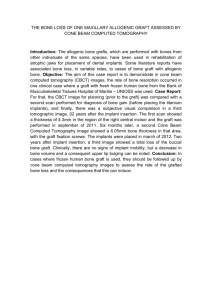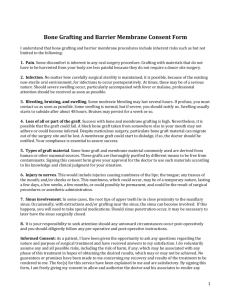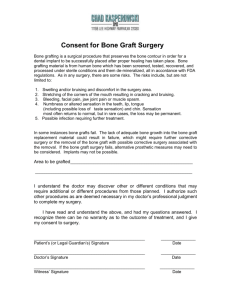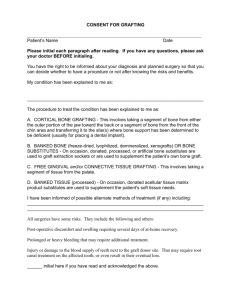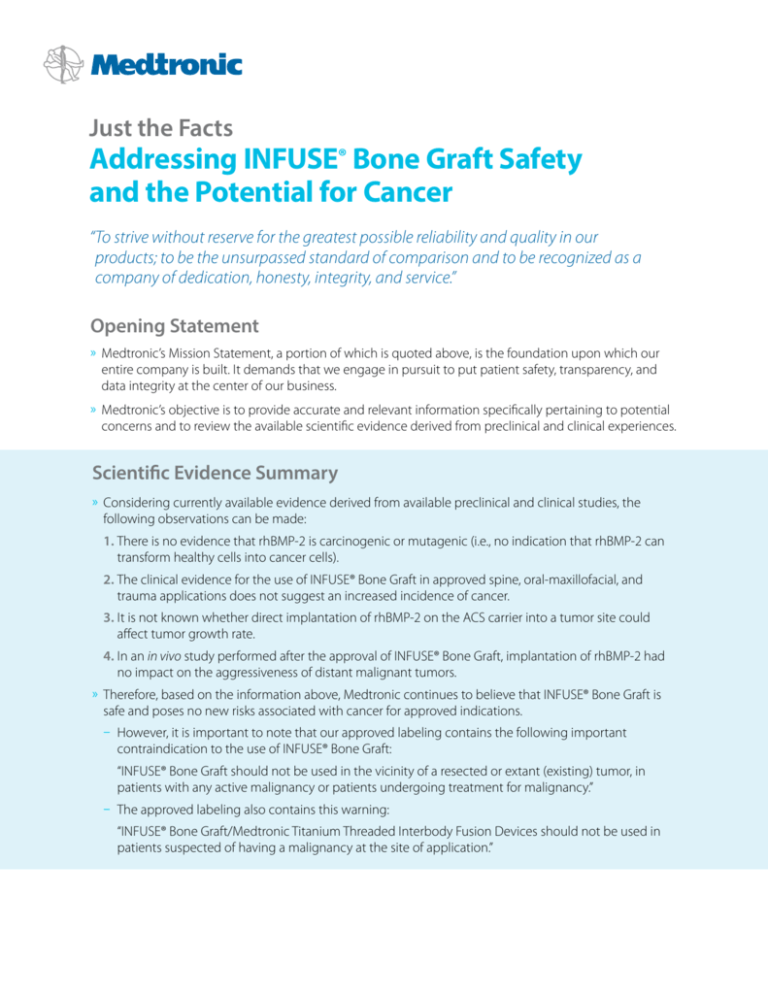
Just the Facts
Addressing INFUSE® Bone Graft Safety
and the Potential for Cancer
“To strive without reserve for the greatest possible reliability and quality in our
products; to be the unsurpassed standard of comparison and to be recognized as a
company of dedication, honesty, integrity, and service.”
Opening Statement
»Medtronic’s Mission Statement, a portion of which is quoted above, is the foundation upon which our
entire company is built. It demands that we engage in pursuit to put patient safety, transparency, and
data integrity at the center of our business.
»Medtronic’s objective is to provide accurate and relevant information specifically pertaining to potential
concerns and to review the available scientific evidence derived from preclinical and clinical experiences.
Scientific Evidence Summary
»Considering currently available evidence derived from available preclinical and clinical studies, the
following observations can be made:
1.There is no evidence that rhBMP-2 is carcinogenic or mutagenic (i.e., no indication that rhBMP-2 can
transform healthy cells into cancer cells).
2.The clinical evidence for the use of INFUSE® Bone Graft in approved spine, oral-maxillofacial, and
trauma applications does not suggest an increased incidence of cancer.
3.It is not known whether direct implantation of rhBMP-2 on the ACS carrier into a tumor site could
affect tumor growth rate.
4.In an in vivo study performed after the approval of INFUSE® Bone Graft, implantation of rhBMP-2 had
no impact on the aggressiveness of distant malignant tumors.
»Therefore, based on the information above, Medtronic continues to believe that INFUSE® Bone Graft is
safe and poses no new risks associated with cancer for approved indications.
–However, it is important to note that our approved labeling contains the following important
contraindication to the use of INFUSE® Bone Graft:
“INFUSE® Bone Graft should not be used in the vicinity of a resected or extant (existing) tumor, in
patients with any active malignancy or patients undergoing treatment for malignancy.”
–The approved labeling also contains this warning:
“INFUSE® Bone Graft/Medtronic Titanium Threaded Interbody Fusion Devices should not be used in
patients suspected of having a malignancy at the site of application.”
2
Addressing INFUSE® Bone Graft Safety and the Potential for Cancer
Background
»There have been questions raised regarding the association between the clinical use of INFUSE® Bone Graft and the
incidence of cancer.
»It is reasonable to ask about the potential for rhBMP-2 to promote cancer growth and development due to a broad
range of expected cellular responses.
–BMP-2 is a powerful protein involved in a myriad of biological processes, such as cell recruitment, cell
differentiation, and new blood vessel formation.
–BMP-2 is a critical molecule as illustrated by the fact that it is essential to embryological development (i.e., a
fetus will not survive if an animal cannot produce it).1
Product Overview
»INFUSE® Bone Graft contains recombinant human bone morphogenetic protein-2 (rhBMP-2), a manufactured
version of a naturally occurring protein, BMP-2, that is important for bone formation and healing. The rhBMP-2
is reconstituted at a concentration of 1.5 mg/ml, and the appropriate volume is applied to an absorbable
collagen sponge (ACS) carrier.
The rhBMP-2 on the ACS carrier at 1.5 mg/ml has demonstrated safety and effectiveness in three separate
PMA approvals:
1.Anterior lumbar interbody fusion (ALIF) with the LT-CAGE® Lumbar Tapered Fusion Devices, INTER FIX™
Threaded Fusion Devices, or INTER FIX™ RP Threaded Fusion Devices;
2. Acute open tibial fracture with intramedullary (IM) nail within 14 days of injury;
3.Sinus augmentations, and for localized alveolar ridge augmentations for defects associated with
extraction sockets.
This document includes labeling information for INFUSE® Bone Graft for Spine, Trauma, and Oral-maxillofacial
applications. However, product indications may vary by geography. Please check with your local Medtronic
representative for the indications and kit availability that are specific to your country.
1. There is no evidence that rhBMP-2 is carcinogenic or mutagenic.
»An extensive literature review conducted in 2013 did not reveal any evidence indicating that transformation of
normal cells into cancer cells by rhBMP-2 can occur.2
»Lack of mutagenicity was verified in a series of standard AMES tests, which are in vitro biological assays used to
assess the mutagenic potential of compounds.3
3
Addressing INFUSE® Bone Graft Safety and the Potential for Cancer
2. The clinical evidence for the use of INFUSE® Bone Graft in approved
applications does not suggest an increased incidence of cancer.
S
S PI N E APPLI C ATI O N
»There are five IDE studies comprising the body of evidence for the use of INFUSE® Bone Graft
(1.5mg/cc rhBMP-2/ACS) in approved spine applications. These studies include:
– INFUSE® Bone Graft with the LT-CAGE® Devices4
•Pilot IDE clinical study
•Randomized IDE clinical study, using an open surgical approach
•Single-arm IDE clinical study, using a laparoscopic surgical approach
– INFUSE® Bone Graft with the INTER FIX™ Devices5
•Randomized pilot IDE clinical study
– INFUSE® Bone Graft with the LT-CAGE® Devices6
•Control group in a randomized IDE clinical study of a lumbar artificial disc
»This pooled dataset contains more patients than those included in the package insert due to the addition of
the last two studies listed above.
»In total, 1047 patients were enrolled and treated, of which 485 received INFUSE® Bone Graft.
»The follow-up endpoints for the INFUSE® Bone Graft patients ranged from 24-72 months, while follow-up for
the non-INFUSE® Bone Graft patients ranged from 24-60 months.
No statistically significant difference was observed in the incidence of malignancy between the INFUSE®
Bone Graft and non-INFUSE® Bone Graft groups in clinical studies for the approved spine indications.
Simple Comparison of Malignancy Cases in Approved Spine Applications
(INFUSE® Bone Graft vs. non-INFUSE® Bone Graft Patients)
INFUSE® Bone
Graft Group
Malignancy Type
Non-INFUSE® Bone
Graft Group
Number of
Cases
Number (%)
of Patients
(n=485)
Number of
Cases
Number (%)
of Patients
(n=562)
p-value
(Fisher’s exact
test)
SEER
Malignancies
9
9 (1.9%)
7
7 (1.2%)
0.46
Not Statistically Significant
Non-SEER
Malignancies
2
2 (0.4%)
1
1 (0.2%)
0.60
Not Statistically Significant
Total
Malignancies
11
10* (2.1%)
8
8 (1.4%)
0.48
Not Statistically Significant
n=number of patients who had any follow-up visit after treatment
*In the INFUSE® Bone Graft group, one patient reported both a SEER and a non-SEER cancer.
This explains the discrepancy in the number of cases vs. the number of patients.
4
Addressing INFUSE® Bone Graft Safety and the Potential for Cancer
S
S PI N E APPLI C ATI O N Continue d
»The SEER (Surveillance, Epidemiology and End Result) Program was developed by the US National Cancer
Institute to categorize cancer events and is recognized as the gold standard for cancer statistics and
cancer surveillance. 7
–This program captures all invasive cancers (e.g., breast cancer).
•An invasive cancer is defined as one that has spread beyond the layer of tissue in which it developed and
is growing into the surrounding healthy tissue.8
–Non-SEER events are not captured in the SEER Program since these are non-invasive cancer types.
•Examples of such events include basal cell carcinoma and squamous cell carcinoma, which are two
common types of skin cancers.9
»This simple analysis does not adjust for differences in duration of follow-up and patient demographics.
–A more appropriate approach is to utilize a time-to-event analysis, which takes into account differences in
follow-up time, as well as patient age, gender, and race, for comparing the two treatment groups.
»When these factors were taken into account, again, no difference was shown between the INFUSE® Bone Graft
and non-INFUSE® Bone Graft groups, both for the rate of SEER malignancies (p=0.63, Cox PHREG) and the rate
of total malignancies (p=0.68, Cox PHREG).10
The distribution of cancer types was broad in both groups, as expected in the general population.
Number of Cases and Types of Malignancies Observed in Approved Spine Applications
SEER Cancer Classification
INFUSE® Bone Graft Group (n=485)
Non-INFUSE® Bone Graft Group (n=562)
Breast
2
1
Colon and Rectum
1
0
Corpus Uteri
0
1
Hodgkin Lymphoma
0
1
Leukemia
0
1
Liver and Bile Duct
1
0
Melanoma of the Skin
2
0
Pancreas
1
0
Prostate
0
1
Testis
1
0
Thyroid
1
2
Total SEER Cancer
9
7
Non-SEER Cancer
2
1
* SEER=Surveillance, Epidemiology and End Result
»The table above provides a complete listing of reported SEER and non-SEER cancers for this population.
»Each case shown in this chart was diagnosed after the patient underwent surgery with INFUSE® Bone Graft.
–Patients were not actively pre-screened for malignancy; however, each patient was asked whether he or she
had an active malignancy prior to enrollment and treatment.
5
Addressing INFUSE® Bone Graft Safety and the Potential for Cancer
S
S PI N E APPLI C ATI O N Continue d
The actual cancer cases observed in both the INFUSE® Bone Graft group and the non-INFUSE® Bone Graft
group were consistent with the rates expected to be seen in the studied patient populations.
Standardized Incidence Ratio (SIR) Analysis in Approved Spine Applications
Malignancy
SEER Category
Number of
Expected
Number of
Observed
SIR
Observed SIR*
95% CI
p-value**
(0.49, 1.86)
0.77
(0.36, 1.67)
0.84
INFUSE® Bone Graft Group
All Cancer Sites
8.30
9
1.08
Non-INFUSE® Bone Graft Group
All Cancer Sites
7.71
7
0.91
*SIR = the number of the observed cases divided by number of the expected cases.
**Mid-P exact test.
»The Standardized Incidence Ratio (SIR) analysis is a standard method utilized by epidemiologists to compare
the observed incidence with that among the normal population.11
»The “expected” number of events calculated from the SIR analysis includes adjustments for such patient factors
as age, gender, and race.
–In the INFUSE® Bone Graft group, the expected number of malignancy cases was 8.30, as compared to 9
actual cases observed.
–In the non-INFUSE® Bone Graft group, the expected number of malignancies was 7.71, as compared to 7
actual cases observed.
6
Addressing INFUSE® Bone Graft Safety and the Potential for Cancer
O
O R AL- M A XI LLO FACIAL APPLI C ATI O N
»There are five IDE studies comprising the body of evidence for the use of INFUSE® Bone Graft in approved
oral-maxillofacial applications. These studies include rhBMP-2 concentrations of 0.43, 0.75, and 1.5 mg/cc on
the absorbable collagen sponge (ACS) carrier. It is important to note that the commercially available product
employs a rhBMP-2 concentration of 1.5 mg/cc on the ACS.
–INFUSE® Bone Graft for Maxillary Sinus Floor Augmentation12
•Safety and Feasibility Pilot IDE clinical study (12 patients receiving 0.43 mg/cc rhBMP-2/ACS)
•Randomized Dosing IDE clinical study (18 patients receiving 0.75 mg/cc rhBMP-2/ACS; 17 patients
receiving 1.5 mg/cc rhBMP-2/ACS)
•Randomized Pivotal IDE clinical study (82 patients receiving 1.5 mg/cc rhBMP-2/ACS)
–INFUSE® Bone Graft for Localized Alveolar Ridge Augmentation13
•Safety and Feasibility Pilot IDE clinical study (12 patients receiving 0.43 mg/cc rhBMP-2/ACS)
•Randomized Dosing IDE clinical study (22 patients receiving 0.75 mg/cc rhBMP-2/ACS; 21 patients
receiving 1.5 mg/cc rhBMP-2/ACS)
»This pooled dataset represents all patients included in the package insert.
»In total, 312 patients were enrolled and treated, of which 184 received rhBMP-2 treatment at any concentration
(0.43 mg/cc, 0.75 mg/cc, or 1.5 mg/cc) on the ACS.
»The follow-up endpoints for both the rhBMP-2-treated and non-rhBMP-2-treated patients ranged from
36-52 months.
No statistically significant difference was observed in the incidence of malignancy between the rhBMP-2
and non-rhBMP-2 groups in clinical studies for the approved oral-maxillofacial indications.
Simple Comparison of Malignancy Cases in Approved Oral-Maxillofacial Applications
(rhBMP-2 Group vs. non-rhBMP-2 Group)
rhBMP-2 Group
Non-rhBMP-2 Group
Number of
Cases
Number (%)
of Patients
(n=184)
Number of
Cases
Number (%) of
Patients
(n=128)
p-value
(Fisher’s exact
test)
SEER
Malignancies
5
5 (2.7%)
3
3 (2.3%)
1.00
Not Statistically Significant
Non-SEER
Malignancies
1
1 (0.5%)
4
4 (3.1%)
0.16
Not Statistically Significant
Total
Malignancies
6
5* (2.7%)
7
7 (5.5%)
0.24
Not Statistically Significant
Malignancy Type
* One patient reported both a SEER and a non-SEER cancer. This explains the difference in the number of cases vs.
the number of patients.
»As with the analysis of the spine data, this simple analysis does not adjust for differences in duration of followup and patient demographics.
»When all of these factors were taken into account with the time-to-event analysis, no difference was shown
between the rhBMP-2 and non-rhBMP-2 groups, both for the rate of SEER malignancies (p=0.89, risk ratio =
1.10 [95% CI: 0.25-4.90], Cox PHREG) and the rate of total malignancies (p=0.20, risk ratio = 0.46 [95% CI: 0.141.52], Cox PHREG).14
7
Addressing INFUSE® Bone Graft Safety and the Potential for Cancer
O
O R AL- M A XI LLO FACIAL APPLI C ATI O N Continue d
The distribution of cancer types was broad in both groups, as expected in the general population.
Number of Cases and Types of Malignancies Observed in Approved Oral-Maxillofacial Applications
SEER Cancer Classification
rhBMP-2 Group (n = 184)
Non-rhBMP-2 Group (n =128)
Brain and Other Nervous System
0
1
Breast
0
1
Colon and Rectum
1
0
Melanoma of the Skin
0
1
Myeloma
1
0
Prostate
2
0
Abdominal Lining**
1
0
Total SEER Cancer
5 (2.7%)
3 (2.3%)
Non-SEER (Skin) Cancer
1 (0.5%)
4 (3.1%)
* SEER=Surveillance, Epidemiology and End Result
** This cancer was considered an invasive cancer, but did not fall into one of the 24 SEER categories.
»The table above provides a complete listing of reported SEER and non-SEER cancers for this population.
»Each case shown in this chart was diagnosed after the patient underwent surgery with INFUSE® Bone Graft.
–Patients were not actively pre-screened for malignancy; however, each patient was asked whether he or she
had an active malignancy prior to enrollment and treatment.
The actual cancer cases observed in both the rhBMP-2 group and the non-rhBMP-2 group were
consistent with the rates expected to be seen in the studied patient populations.
Standardized Incidence Ratio (SIR) Analysis in Approved Oral-Maxillofacial Applications
Malignancy
SEER Category
Number of
Expected
Number of
Observed
SIR
Observed SIR*
95% CI
p-value**
(0.32, 1.92)
0.94
(0.21, 2.19)
0.89
rhBMP-2 Group
All Cancer Sites
5.3
5
0.94
Non-rhBMP-2 Group
All Cancer Sites
3.4
3
0.88
*SIR = the number of the observed cases divided by number of the expected cases.
**Mid-P exact test.
»The “expected” number of events calculated from the SIR analysis includes adjustments for such patient factors
as age, gender, and race.
–In the rhBMP-2 group, the expected number of malignancy cases was 5.3, as compared to 5 actual
cases observed.
–In the non-rhBMP-2 group, the expected number of malignancies was 3.4, as compared to 3 actual
cases observed.
8
Addressing INFUSE® Bone Graft Safety and the Potential for Cancer
T
TR AUM A APPLI C ATI O N
»There are two IDE studies comprising the body of evidence for the use of INFUSE® Bone Graft in approved
trauma applications. These studies include:
–INFUSE® Bone Graft for Acute, Open Fractures of the Tibia15
•Randomized Dosing Pivotal IDE clinical study (151 patients receiving 0.75 mg/cc rhBMP-2/ACS; 149
patients receiving 1.5 mg/cc rhBMP-2/ACS)
–INFUSE® Bone Graft with Reamed Locked Intramedullary Nail Fixation16
• Post-market clinical study
»This pooled dataset contains more patients than those included in the package insert due to the addition of
the last study listed above.
»In total, 721 patients were enrolled and treated, of which 151 patients received rhBMP-2/ACS at 0.75 mg/cc and
286 patients received rhBMP-2/ACS at 1.5 mg/cc (437 total patients receiving rhBMP-2/ACS treatment).
»The follow-up endpoints for both the rhBMP-2-treated and non-rhBMP-2-treated patients were 12 months.
»No cancer was reported in any of the treatment groups in the Pivotal IDE clinical study. One (1) cancer
(prostate) was reported in INFUSE® Bone Graft group in the post-market study. This difference was not
statistically significant.
»Because of the low number of reported malignancies, more in-depth analyses (like those performed for the
approved spine and oral-maxillofacial indications above) were not performed.
9
Addressing INFUSE® Bone Graft Safety and the Potential for Cancer
3. It is not known whether direct implantation of rhBMP-2 on the ACS
carrier into a tumor site could affect tumor growth rate.
»Many cell types have BMP receptors. This indicates their ability to respond to BMP, although the exact response
in each cell type at each stage of development is not yet known.
»Review of the current literature investigating the effects of direct exposure of rhBMP-2 on cancer cell lines has
suggested both positive and negative effects. Whether the effects are positive or negative is highly dependent
on the cell culture medium used, exposure regimen, and type and stage of progression of cell line used.17
»Beginning in the early 1990s, several cell culture studies performed by Medtronic’s partner showed no growth
stimulation and, in some cases, growth inhibition of cancer cell lines in response to rhBMP-2 exposure.18
–However, it was not verified whether these primary tumor cell lines or tumor isolates could respond to BMP
since the presence of receptors was not determined as part of this study.
Summary of Preclinical In Vitro Studies
Type of Study
Samples Tested
Results
Tumor cell line study
(rhBMP-2 – 0-1000 ng/mL)
14 cell lines, including
osteosarcoma, breast, prostate,
and lung cancer
All cell lines either unaffected or
growth inhibited
Tumor isolates study
(rhBMP-2 – 10, 100, 1000 ng/mL)
65 evaluable samples from
patients
(17 breast, 15 ovarian, 14 lung)
None showed growth
stimulation – 16 of 65 inhibited
at 1000 ng/ml
Year Completed
1991
1998
»rhBMP-2 is at least indirectly angiogenic.
–While no tumors have been observed at the site of INFUSE® Bone Graft implantation in the IDE clinical trials,
a local increase in blood vessel formation could theoretically enhance existing tumor growth in the vicinity
or re-growth of a resected tumor.19
–Since the product was released in 2002, a contraindication has been in place advising against the
implantation of INFUSE® Bone Graft in the vicinity of a resected or extant (existing) tumor.
10
Addressing INFUSE® Bone Graft Safety and the Potential for Cancer
4. In an in vivo study performed after the approval of INFUSE® Bone
Graft, implantation of rhBMP-2 had no impact on the aggressiveness of
distant malignant tumors.
»In order for rhBMP-2 to have an effect on cells, the protein must reach the cell and bind to its BMP receptors at
a sufficient concentration for a sufficient duration to stimulate a response.
»rhBMP-2 acts locally at the site of implantation because systemic exposure is minimized. It is retained at the
site by the ACS carrier, slowly released over several weeks, and rapidly cleared from circulation. In addition, the
protein is rapidly catabolized in the body.
»Although growth was not detected in the cell culture studies above, animal studies were conducted following
the approval of INFUSE® Bone Graft to examine the potential for tumor growth remote from the implantation
site to occur.
–Tumor cells, confirmed to have BMP receptors, were implanted subcutaneously on one flank in nude mice.
–On the opposite flank, rhBMP-2/ACS was simultaneously implanted.
•To model a worst case scenario, the concentrations of rhBMP-2 were four to 40 times greater than that
commonly used to form bone in this animal model.20
»It is unknown how these data translate to the clinical setting in humans.
Post-Approval* Preclinical Study Summary
Type of Study
Samples Tested
Assessment of tumor cell lines for Screened 21 cancer cell lines for
rhBMP-2 receptors
BMP receptor mRNA
Results
Year Completed
10 of 21 cell lines had
functionally relevant levels of
receptor mRNA
In vitro tumor cell line study
(rhBMP-2 – 0-100 ng/mL)
10 receptor-positive cell lines and No effect on 10 cell lines –
1 osteosarcoma
one prostate line was inhibited
In vivo implantation of tumor
cells and rhBMP-2/ACS (0.4 &
4 mg/mL) at remote location
in mice
5 cell lines that express BMP
receptors and 2 that do not
No increase in tumor growth or
metastasis
2002
2002
2004
* Performed as part of post-approval conditions for INFUSE® Bone Graft, PMA P000058.
Conclusions/Next Steps
»The preclinical data demonstrate no evidence that rhBMP-2 is carcinogenic or mutagenic (i.e., no indication
that rhBMP-2 can transform healthy cells into cancer cells). In addition, in Medtronic’s in vivo post-approval
animal study, no increase in tumor growth or metastasis was observed.
»Based on data from the Medtronic clinical studies examining INFUSE® Bone Graft/Medtronic Titanium Threaded
Interbody Fusion Devices for ALIF, the use of INFUSE® Bone Graft did not have a statistically significant impact
on the occurrence of cancer.
»The body of evidence outlined above supports Medtronic’s belief that INFUSE® Bone Graft is safe and effective
when used for the approved indications and in a manner consistent with the instructions for use.
»Medtronic remains committed to transparency, and ensuring patient safety for INFUSE® Bone Graft and every
product we deliver to market.
Have questions about INFUSE® Bone Graft (rhBMP-2/ACS) use? Contact the Office of Medical Affairs at
(901) 399-2044; (800) 876-3133, extension 6044; or rs.msdoma@medtronic.com.
11
Addressing INFUSE® Bone Graft Safety and the Potential for Cancer
Brief Summaries
BRIEF SUMMARY OF INDICATIONS, CONTRAINDICATIONS, AND WARNINGS FOR:
INFUSE® BONE GRAFT/LT-CAGE® LUMBAR TAPERED FUSION DEVICE
INFUSE® BONE GRAFT/INTER FIX™ THREADED FUSION DEVICE
INFUSE® BONE GRAFT/INTER FIX™ RP THREADED FUSION DEVICE
The INFUSE® Bone Graft/Medtronic Titanium Threaded Interbody Fusion Device is indicated for spinal fusion procedures in skeletally mature patients with
degenerative disc disease (DDD) at one level from L2-S1, who may also have up to Grade I spondylolisthesis or Grade 1 retrolisthesis at the involved level.
The INFUSE® Bone Graft/LT-CAGE® Lumbar Tapered Fusion Device is to be implanted via an anterior open or an anterior laparoscopic approach. INFUSE®
Bone Graft with either the INTER FIX™ or INTER FIX™ RP Threaded Fusion Device is to be implanted via an anterior open approach. The INFUSE® Bone Graft/
Medtronic Titanium Threaded Interbody Fusion Device consists of two components containing three parts– a metallic spinal fusion cage, a recombinant
human bone morphogenetic protein and a carrier/scaffold for the bone morphogenetic protein and resulting bone. These components must be used as
a system for the prescribed indication described above. The bone morphogenetic protein solution component must not be used without the carrier/
scaffold component or with a carrier/scaffold component different from the one described in this document. The INFUSE® Bone Graft component
must not be used without the Medtronic Titanium Threaded Interbody Fusion Device component.
NOTE: The INTER FIX™ Threaded Fusion Device and the INTER FIX™ RP Threaded Fusion Device may be used together to treat a spinal level. LT-CAGE®
Lumbar Tapered Fusion Device implants are not to be used in conjunction with either the INTER FIX™ or INTER FIX™ RP implants to treat a spinal level.
The INFUSE® Bone Graft/Medtronic Titanium Threaded Interbody Fusion Device is contraindicated for patients with a known hypersensitivity to
recombinant human Bone Morphogenetic Protein-2, bovine Type I collagen or to other components of the formulation and should not be used in the
vicinity of a resected or extant tumor; in patients with any active malignancy or patients undergoing treatment for a malignancy; in patients who are
skeletally immature; in pregnant women; or in patients with an active infection at the operative site or with an allergy to titanium or titanium alloy. There
are no adequate and well-controlled studies in human pregnant women. In an experimental rabbit study, rhBMP-2 has been shown to elicit antibodies that
are capable of crossing the placenta. Women of child bearing potential should be warned by their surgeon of potential risk to a fetus and informed of other
possible orthopedic treatments. The safety and effectiveness of this device has not been established in nursing mothers. Women of child-bearing potential
should be advised to not become pregnant for one year following treatment with this device.
Please see the package insert for the complete list of indications, warnings, precautions, adverse events, clinical results, definition of DDD, and other
important medical information. The package insert also matches the sizes of those sized devices that are indicated for use with the appropriate
INFUSE® Bone Graft kit.
CAUTION: Federal (USA) law restricts this device to sale by or on the order of a physician with appropriate training or experience.
BRIEF SUMMARY OF INDICATIONS, CONTRAINDICATIONS, AND WARNINGS FOR:
INFUSE® BONE GRAFT
INFUSE® Bone Graft is indicated for treating acute, open tibial shaft fractures that have been stabilized with IM nail fixation after appropriate wound
management. INFUSE® Bone Graft must be applied within 14 days after the initial fracture. Prospective patients should be skeletally mature.
INFUSE® Bone Graft consists of two components – recombinant human Bone Morphogenetic Protein-2 solution and a carrier/scaffold for the bone
morphogenetic protein solution and resulting bone. These components must be used as a system. The bone morphogenetic protein solution
component must not be used without the carrier/scaffold component or with a carrier/scaffold component different from the one described in this
document.
INFUSE® Bone Graft is contraindicated for patients with a known hypersensitivity to recombinant human Bone Morphogenetic Protein-2, bovine Type
I collagen or to other components of the formulation and should not be used in the vicinity of a resected or extant tumor, in patients with an active
malignancy or patients undergoing treatment for a malignancy. INFUSE® Bone Graft should also not be used in patients who are skeletally immature,
in patients with an inadequate neurovascular status, in patients with compartment syndrome of the affected limb, in pregnant women, or in patients
with an active infection at the operative site. There are no adequate and well controlled studies in human pregnant women. In an experimental rabbit
study, rhBMP-2 has been shown to elicit antibodies that are capable of crossing the placenta. Women of child bearing potential should be warned by
their surgeon of potential risk to a fetus and informed of other possible orthopedic treatments. The safety and effectiveness of this device has not been
established in nursing mothers. Women of child-bearing potential should be advised to not become pregnant for one year following treatment with
this device.
Please see the package insert for the complete list of indications, warnings, precautions, adverse events, clinical results, and other important
medical information.
CAUTION: Federal (USA) law restricts this device to sale by or on the order of a physician with appropriate training or experience.
BRIEF SUMMARY OF INDICATIONS, CONTRAINDICATIONS, WARNINGS, AND PRECAUTION FOR INFUSE® BONE GRAFT FOR CERTAIN
ORAL MAXILLOFACIAL AND DENTAL REGENERATIVE USES
INFUSE® Bone Graft is indicated as an alternative to autogenous bone graft for sinus augmentations, and for localized alveolar ridge augmentations for
defects associated with extraction sockets. The INFUSE® Bone Graft consists of two components – recombinant human Bone Morphogenetic Protein-2
(rhBMP-2) placed on an absorbable collagen sponge (ACS). These components must be used as a system for the prescribed indication. The bone
morphogenetic protein solution component must not be used without the carrier/scaffold component or with a carrier/scaffold component different
from the one described in the package insert.
INFUSE® Bone Graft is contraindicated for patients with a known hypersensitivity to recombinant human Bone Morphogenetic Protein-2, bovine Type
I collagen or to other components of the formulation and should not be used in the vicinity of a resected or extant tumor, in patients with any active
malignancy or patients undergoing treatment for a malignancy, in pregnant women, or patients with an active infection at the operative site. There are no
adequate and well-controlled studies in human pregnant women. In an experimental rabbit study, rhBMP-2 has been shown to elicit antibodies that are
capable of crossing the placenta. Women of child bearing potential should be warned by their surgeon of potential risk to a fetus and informed of other
possible dental treatments. The safety and effectiveness of this device has not been established in nursing mothers. Women of child-bearing potential
should be advised to not become pregnant for one year following treatment with this device. INFUSE® Bone Graft has not been studied in patients who are
skeletally immature (<18 years of age or no radiographic evidence of epiphyseal closure).
Please see the package insert for the complete list of indications, warnings, precautions, adverse events, clinical results, and other important
medical information.
References
1Zhang, Hongbing and Bradley, Allan, Mice deficient for BMP2 are nonviable and have defects in amnion/chorion and cardiac development.
Development 122, 2977-2986 (1996).
2 Data on file.
3INFUSE® Bone Graft Summary of Safety & Effectiveness Data. P000058 (2002).
4 Data on file.
5 Data on file.
6 Data on file.
7National Cancer Institute, Surveillance Epidemiology and End Results. seer.cancer.gov (last accessed November 14, 2011).
8 National Cancer Institute, Dictionary of Cancer Terms. www.cancer.gov/dictionary (last accessed November 14, 2011).
9National Cancer Institute, Dictionary of Cancer Terms. www.cancer.gov/dictionary (last accessed November 14, 2011).
10 Data analysis on file.
11National Cancer Institute, Surveillance Epidemiology and End Results. http://seer.cancer.gov/seerstat/WebHelp/Standardized_Incidence_Ratio_and_
Confidence_Limits.htm (last accessed November 14, 2011).
12 Data on file.
13Data on file.
14Data on file.
15 Data on file.
16 Data on file.
17 Data on file.
18Data on file. See also INFUSE® Bone Graft Summary of Safety & Effectiveness Data, P000058 (2002).
19Oklu et al., Angiogenesis and Current Antiangiogenic Strategies for the Treatment of Cancer, J Vasc Interv Radiol, 21, 1791-1805 (2010).
20Data on file
Medtronic
Spinal and Biologics Business
Worldwide Headquarters
2600 Sofamor Danek Drive
Memphis, TN 38132
1800 Pyramid Place
Memphis, TN 38132
(901) 396-3133
(800) 876-3133
Customer Service: (800) 933-2635
For more information go to www.myspinetools.com
LITINFCBRO14 ©2014 Medtronic Sofamor Danek USA, Inc. All Rights Reserved. PMD011510-2.0 29870
www.medtronic.com


